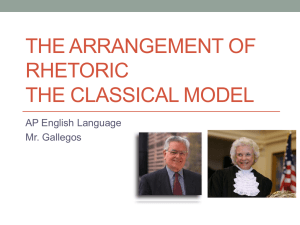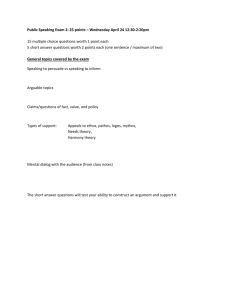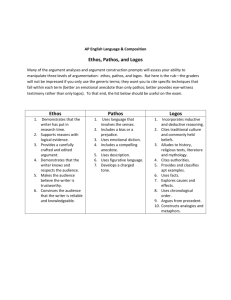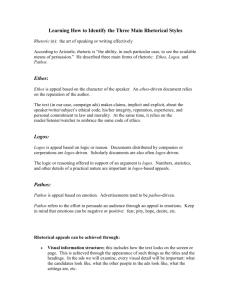An Introduction to Rhetoric
advertisement
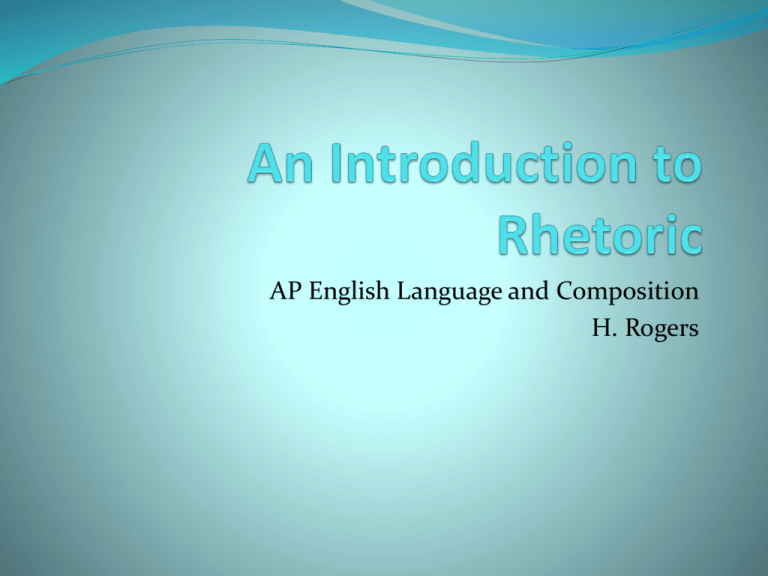
AP English Language and Composition H. Rogers Rhetoric Defined Aristotle: Rhetoric is "the faculty of discovering in any particular case all of the available means of persuasion." Plato: [Rhetoric] is the "art of enchanting the soul." (The art of winning the soul by discourse.) Philip Johnson: "Rhetoric is the art of framing an argument so that it can be appreciated by an audience." Andrea Lunsford: "Rhetoric is the art, practice, and study of human communication." Lou Gehrig Nicknamed “The Iron Horse,” Lou Gehrig was one of the most talented and accomplished men to ever play the game of baseball. His accomplishments on the field made him an authentic American hero and his tragic early death made him a hero. http://www.americanrhetoric.co m/speeches/lougehrigfarewellto baseball.htm Why is this an effective speech? Context (or occasion):Lou Gehrig delivered this speech at an Appreciation Day held in his honor on July 4, 1939. He gave the speech between games of a doubleheader. The more important context is the poignant contrast between the celebration of his athletic career and the life-threatening diagnosis he had received. Why is this an effective speech? Purpose: Within the given context, Gehrig’s goal is to remain positive by looking on the bright side – his past luck and present optimism – an downplaying the bleak outlook. Makes only one reference to his diagnosis “bad break” Thesis (or claim or assertion): Gehrig’s is crystal clear: “He’s the luckiest man on the face of the earth.” Subject: Gehrig knows his subject – baseball in general, the New York Yankees in particular. Why is this an effective speech? Speaker: Though Gehrig is a baseball champion, he is not a polished orator or a highly sophisticated writer; therefore, as a speaker, he presents himself as a common man, modest and glad for the life he’s lived. Audience: Fans and fellow athletes, both those in the stadium and those who will hear the speech from afar, and people rooting for him on and off the field. Why is this an effective speech? Gehrig’s understanding of how these factors – subject (main idea), speaker, and audience – interact determines his speech: a plainspoken, positive appreciation for what he has had, and a champion’s courageous acceptance of the challenges that lie before him. One commentator wrote, “Lou Gehrig’s speech almost rocked Yankee Stadium off its feet.” The Rhetorical Triangle The Rhetorical Triangle or the Aristotelian Triangle Audience Persona of speaker/writer Interaction among subject, speaker, and audience determines the structure and language of the argument. Subject Appeals The writer/speaker uses appeals to support his/her meaning: Ethos Logos Pathos Ethos Names the persuasive appeal of one's character, especially how this character is established by means of the speech or discourse. Speakers appeal to ethos to demonstrate that they are credible and trustworthy. Aristotle claimed that one needs to appear both knowledgeable about one's subject and benevolent. Cicero said that in classical oratory the initial portion of a speech (its exordium or introduction) was the place to establish one's credibility with the audience. A person’s reputation or background might provide them ethos. The writing itself might provide ethos by being balanced, reasonable, sincere, knowledgeable, etc Logos Names the appeal to reason. Aristotle wished that all communication could be transacted only through this appeal, but given the weaknesses of humanity, he laments, we must resort to the use of the other two appeals. Pathos Names the appeal to emotion. Cicero encouraged the use of pathos at the conclusion of an oration, but emotional appeals are of course more widely viable. Identifying Ethos, Logos, and Pathos \\oglethorpe\shares\HS Faculty\hlawrence\My Documents\AP\We Can Afford to Give Parents a Break.docx Arrangement Another element of rhetoric is the organization of a piece, what classical rhetoricians called arrangement. The Classical Model: Introduction Narration Confirmation Refutation Conclusion Introduction Exordium Introduces the reader to the subject In Latin, exordium means “beginning a web” Should draw in the readers by piquing their interest Often establishes ethos Narration Narratio Provides factual information and background material on the subject at hand Begins the developmental paragraphs, or establishes why the subject is a problem that needs addressing Level of detail of this section depends on audience’s knowledge of subject Appeals to logos and pathos Confirmation Confirmatio Usually the major part of the text Includes the development or the proof needed to make the writer’s case – the nuts and bolts of the essay, containing the most specific and concrete detail in the text Usually makes the strongest appeal to logos Refutation Refutatio Addresses the counterargument Is a bridge between the proof and conclusion Usually recommended to be at the end, but not a hard- and-fast rule If opposing views are well known or valued by the audience, a writer/speaker will address them before presenting his/her own argument. Mostly appeal to logos Conclusion Peroratio May be one paragraph or several Brings the essay/speech to a satisfying close Usually appeals to pathos and reminds audience of the ethos established earlier Rather than simply repeating what has gone before, the conclusion brings all the writer’s ideas together and answers the question, so what? The classical rhetorician’s advice is that the last words and ideas of a text are those the audience is most likely to remember. The Classic Model at Work Not By Math Alone Patterns of Development Another way to consider arrangement is according to purpose. These patterns of development include a range of logical ways to organize an entire text or, more likely, individual paragraphs or sections. Narration Refers to telling a story or recounting a series of events. Can be based on personal experience or on knowledge from reading or observation. Chronology usually governs narrations Includes concrete detail, a point of view, and sometimes dialogue Narration is not simply crafting an appealing story; it’s crafting a story that supports your thesis. Writers often use narration as a way to enter their topics. Description Closely related to narration because both include many specific details. Unlike narration, description emphasizes the senses by painting a picture of how something looks, sounds, smells, tastes, or feels. Often used to establish mood or atmosphere Rarely is an entire essay descriptive, but clear descriptive writing can make an essay more persuasive Process Analysis Explains how something works, how to do something, or how something is/was done. The key to successful process analysis is clarity: it is important to explain a subject clearly and logically, with transitions that mark the sequence of major steps, stages, ,or phases of the process. Comparison and Contrast A common pattern of development; juxtaposes two things to highlight their similarities and differences. Used to analyze information carefully, which often reveals insight into the nature of the information being analyzed. Often required on examinations where you have to discuss various aspects of two pieces of text May be organized subject-by-subject or point-by-point Classification and Division By answering the question, What goes together and why? Writers and reader can make connections between things that might otherwise seem unrelated. Most of the time a writer’s task is to develop his or her own categories, to find a distinctive way of breaking down a larger idea or concepts into parts. Definition To ensure that writers and their audiences are speaking the same language, definition may lay the foundation to establish common ground or identifying areas of conflict. Defining a term is often the first step in a debate or disagreement. In some cases, the definition is only a paragraph or two; in other cases, it takes up the whole essay. Exemplification Providing a series of examples – facts, specific cases, or instances – turns a general idea into a concrete one; this makes your argument both clearer and more persuasive to a reader. A writer might use extended examples or a series of related ones to illustrate a point. Aristotle taught that examples are a type of logical proof called induction. That is, a series of specific examples that leads to a general conclusion. Cause and Effect Analyzing cause and effect can be a powerful argument. It is important to carefully trace a chain of cause and effect and to recognize possible contributing factors. Cause and effect is often signaled by a why in the title or opening paragraph. Sources The Language of Composition by Renee H. Shea, Lawrence Scanlon, and Robin Dissin Aufses http://rhetoric.byu.edu/canons/Canons.htm http://www.americanrhetoric.com

